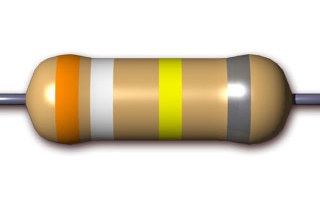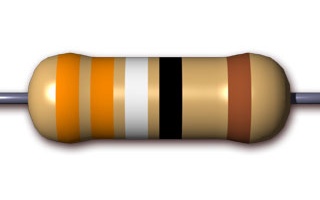Resistor, one of the most common electronic component. They are used to control current flow in a circuit, and are rated by their resistance value and their power rating.

Typical Axial-lead Resistors
The unit measurement of a resistor is ohm (symbol: Ω), named after Georg Simon Ohm. An ohm is equivalent to a volt per ampere.
How to read a resistor color?
Resistor values are marked on the resistor by using the color band code. To identify its value, each resistor is marked with four or five colored bands. Each color represents a number value, so by reading the color values it is possible to identify its resistance value. The chart below explains resistor colors. It is good practice to memorise the various colors and their respective values.

Resistor Color Code Table
Resistors are manufactured to a tolerance of 1, 2, 5 and 10%. Normally each resistor marked with either 4 or 5 color bands.

390kΩ with 10% tolerance
If a resistor comes with 4 color bands, the 1st 2 bands represent it values, 3rd band represents the multiplier value and the last band indicates the tolerance. Orange 3, White 9, Yellow 10,000 and Silver 10%, so it will be a 390kΩ with 10% tolerance resistor.

339Ω with 1% tolerance
If a resistor come with 5 color bands, the 1st 3 bands represents its values, the 4th band represents the multiplier and the last band represents the tolerance. Orange 3, Orange 3, White 9, Black 1 and Brown 1%, so it will be a 339Ω with 1% tolerance resistor.
If your want to learn more about basic electronics, you can consider this book Understanding Basic Electronics (2nd Edition).




What’s up it’s me, I am also visiting this
website regularly, this website is really pleasant and the people
are truly sharing fastidious thoughts.
I’m really enjoying the design and layout of your site.
It’s a very easy on the eyes which makes it much more enjoyable for me to come
here and visit more often. Did you hire out a designer
to create your theme? Outstanding work!
Hello colleagues, how is all, and what you wish for to say on the topic of this paragraph, in my view its truly remarkable for me.